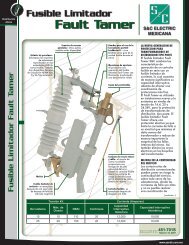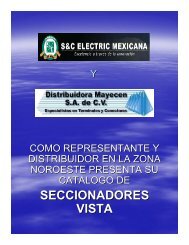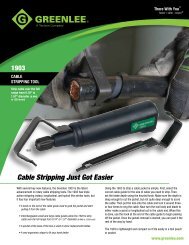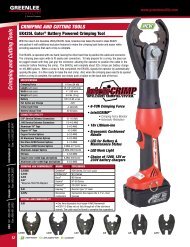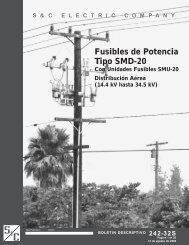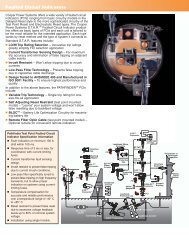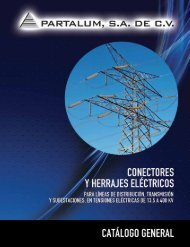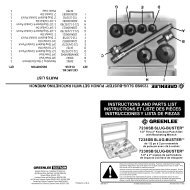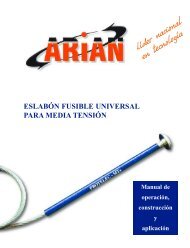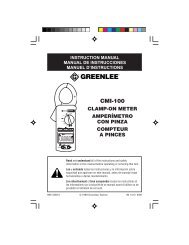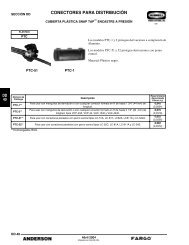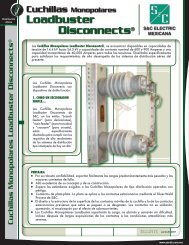OVERHEAD LINE SPLICES
OVERHEAD LINE SPLICES
OVERHEAD LINE SPLICES
- No tags were found...
You also want an ePaper? Increase the reach of your titles
YUMPU automatically turns print PDFs into web optimized ePapers that Google loves.
REFERENCE DATASECTION DJALUMINUM AND BRONZE CONNECTORSALLOYS, CONNECTORS, HARDWARE & INSTALLATIONIn over 100 years of serving the electrical industry, Anderson has earned a reputation for being a creative leader in the designand manufacture of electrical connectors, fittings and related accessories. The Anderson acceptance of these responsibilities isbest exemplified through our wholly self-sufficient facilities. Design Engineering, Testing and Metallurgical Laboratories, andall facets of Manufacturing are geared for research, development and production of a full line of quality bronze, aluminum andductile iron products.The following information conveys helpful reference for material composition, installation, standardization and definitions applyingto connectors and fittings as developed during our years of experience.ALUMINUM CONNECTORSAluminum Alloys:Connectors and fittings requiring high mechanical propertiesare cast from aluminum alloy 356. Sand cast 356 is heat treatedto the T6 temper, and permanent mold castings are heat treatedto the T61 temper. The 356 alloy is a 7 per cent silicon—0.3per cent magnesium-aluminum alloy. The alloy is not susceptibleto stress corrosion or season cracking. Its volume conductivityis approximately 39 per cent, I.A.C.S.Cast compression connectors requiring a soft high conductivityaluminum are supplied from 99 plus per cent pure aluminum.Other aluminum compression connectors are made fromcommercially pure high conductivity wrought aluminum.Installation Recommendations For AluminumConnectorsSelect type of connector from those listed below and followthe indicated procedure.CONNECTOR TYPEINSTALLATION PROCEDUREBolted ....................................Procedure #1Welded ..................................Procedure #2Compression .........................Procedure #3Welded and Bolted ................Procedure #2 followed by Procedure #1Compression and Bolted .......Procedure #3 followed by Procedure #1Welded and Compression .....Procedure #2 followed by Procedure #3PROCEDURE #1—BOLTED CONNECTIONSA. For aluminum to aluminum connections and aluminum tocopper connections without a copper lined contact.1. Vigorously clean all contact surfaces of the connectorand conductor with a stiff stainless steel wire brush toremove oxides. A typically bright aluminum surfaceshould be obtained. Do Not Wire Brush Plated ContactSurfaces.2. Immediately coat these contact areas with a liberalamount of contact sealant.3. Install fitting with bolts finger tight. If a generous beadof compound does not appear, remove the conductorand add more sealant.4. Alternately (criss-cross) and evenly tighten bolts witha torque wrench to the values shown on page 6.5. Excess sealant squeezed out of joint can be left as is orcan be lightly smoothed along contact line.6. All excess sealant must be removed from EHV Connectorsand entirely from cable insulation.B. For Aluminum connectors with a copper liner to copperconnection.1. For maximum corrosion protection of the joint, thesteps given in A-1 to A-5 should be followed.PROCEDURE #2—WELDED CONNECTIONSA. For cable connections:1. Remove all oil, grease and water in vicinity of surfacesto be welded. Vigorously clean the conductor and connectorwelding areas with a stainless steel brush.2. Slide the conductor into the weldment cavity until it iswithin 1/8” to 3/16” of the rear of the welding barrel.3. Prior to welding the connection, a test bead should bemade upon an aluminum casting to test the weld settings.(See our catalog Section G - Substation Connectorsfor detailed welding procedure).4. Begin welding by “burning into” the inner wall of thecasting and proceeding toward the conductor center.Wire brush the original weld if more than one weldpass is required.B. For tubular connections:1. Remove all oil, grease and water in vicinity of surfacesto be welded. Vigorously clean the conductor and connectorwelding areas with a stainless steel brush.2. Align the tubular bus and connector groove. Beginwelding by “burning into” the inner wall of the castingand proceeding toward the conductor center. Wirebrush the original weld if more than one weld pass isrequired.3. Prior to welding the connection, a test bead should bemade upon an aluminum casting to test the weld settings.(See our catalog Section G - Substation Connectorsfor detailed welding procedure).4. Due to the manufacturing tolerances on aluminumtubular bus, it is recommended that the tube be positionedin the weldment cavity and tack welded beforestarting final weld.DJ1DJ-1HUBBELL ® Power Systems August 2010




